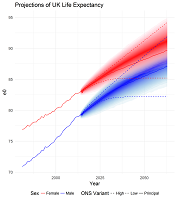
Predicting births and deaths
Forecasts of mortality provide vital information about our future population of elderly citizens, with implications for pension and health-care policy as well as for decisions made by private companies about life insurance and pensions. Fertility is a dynamic social process that is influenced by a range of economic and cultural factors. This complicates the process of forecasting future numbers of births, as the direction and magnitude of changes in fertility rates are consequently much less predictable than they are for death rates.
CPC members, Jason Hilton, Erengul Dodd, Jon Forster, Jakub Bijak and Peter Smith, have developed innovative new models for the probabilistic forecasting of fertility and mortality that provide not only single values for the number of births and deaths expected in the future, but also the degree of certainty around these numbers. When combined with migration projections, such methods can be used to predict population totals, broken down by age group and incorporating our uncertainty about the future.
On the research, Dr Hilton comments: “Forecasting not only the most probable future number of births or deaths but also the range of likely values provides decisionmakers with the opportunity to manage possible risks, for instance by preparing for more extreme scenarios that, without adequate planning, could lead to financial or logistic problems. Probabilistic forecasts such as these can inform policy questions where it could be crucial to know the likelihood that a forecast will under- or over-predict.”
Further reading:
Projecting UK mortality using Bayesian generalised additive models (Journal of the Royal Statistical Society. Series C: Applied Statistics)
Posted 01/02/2019 10:43
Back






